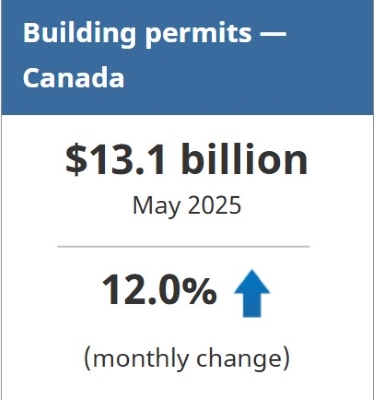Statistics Canada: Building Permits, May 2025

In May, the total value of building permits issued in Canada rose by $1.4 billion (+12.0%) to reach $13.1 billion. The increase in construction intentions was driven by Ontario’s institutional component (+$1.3 billion).
On a constant dollar basis (2023=100), the total value of building permits issued in May increased 11.8% from the previous month and was up 5.1% on a year-over-year basis.
Ontario’s institutional component drives non-residential construction intentions
The value of non-residential building permits sharply increased by $1.2 billion to $5.6 billion in May, driven by Ontario’s institutional component (+$1.3 billion). Construction intentions for a new hospital in the Niagara census metropolitan area (CMA), which reached almost seven times the average value of major permits in the institutional component, led the growth in Ontario’s institutional component. The hospital construction permit also drove the national institutional component upwards to a record $2.5 billion. In constant dollar terms, the institutional component also reached a series high.
Commercial permit values increased by $87.8 million to $2.3 billion in May. Quebec (+$59.1 million) led the gains recorded in eight provinces and two territories. Ontario permit values (-$71.9 million) declined the most, after contributing significantly to growth in the non-residential sector in April.
Construction intentions in the industrial component declined by $117.2 million in May; the largest decline was in Quebec (-$50.8 million), followed by decreases in six other provinces.
British Columbia’s multi-family permits lead the residential sector
Residential construction intentions rose by $169.8 million to $7.5 billion in May. This increase was primarily led by British Columbia’s multi-family component, which grew by $687.7 million to $1.5 billion.
British Columbia’s multi-family component growth in May was driven by the Vancouver CMA (+$696.4 million), which rebounded after dipping in April.
Nationally, multi-family permit values increased by $194.8 million to $4.9 billion in May. Ontario’s multi-family component declined by $382.8 million, counteracting part of the growth in British Columbia’s multi-family component.
The value of single-family permits edged down $25.0 million to $2.6 billion in May, with the decline primarily attributed to Ontario (-$77.5 million) and mitigated by increases in seven provinces and two territories.
Across Canada, a total of 21,000 new multi-unit dwellings and 4,400 new single-family dwellings were authorized for construction in May, reflecting a slight decline of 0.2% in the total number of units authorized from the previous month.
To explore data using an interactive user interface, visit the Building permits: Interactive Dashboard.
For more information on construction, please visit the Construction statistics portal.
For more information on housing, please visit the Housing statistics portal.
Note to readers
Unless otherwise stated, this release presents seasonally adjusted data with current dollar values, which facilitate month-to-month and quarter-to-quarter comparisons by removing the effects of seasonal variations. For information on seasonal adjustment, see Seasonally adjusted data – Frequently asked questions.
For information on trend-cycle data, see the page Trend-cycle estimates – Frequently asked questions.
Data may not add up to totals as a result of rounding.
Building components
- Single-family dwellings: Residential buildings containing only one dwelling unit (e.g., single-detached house, bungalow, linked home [linked at the foundation]).
- Multi-family dwellings: Residential buildings containing multiple dwelling units (e.g., apartment, apartment condominium, row house, semi-detached house).
- Industrial buildings: Buildings used in the processing or production of goods or related to transportation and communication.
- Commercial buildings: Buildings used in the trade or distribution of goods and services, including office buildings.
- Institutional and government buildings: Buildings used to house public and semi-public services, such as those related to health and welfare, education or public administration, and buildings used for religious services.
Revision
Data are subject to revisions based on late responses, methodological changes and classification updates. Unadjusted data in current dollars have been revised for the previous month; unadjusted data in constant dollars have been revised for the previous two months. Seasonally adjusted data in current dollars have been revised for the previous two months; seasonally adjusted data in constant dollars have been revised for the previous three months.
Next release
Data on building permits for June will be released on August 12.
Source: Statistics Canada


